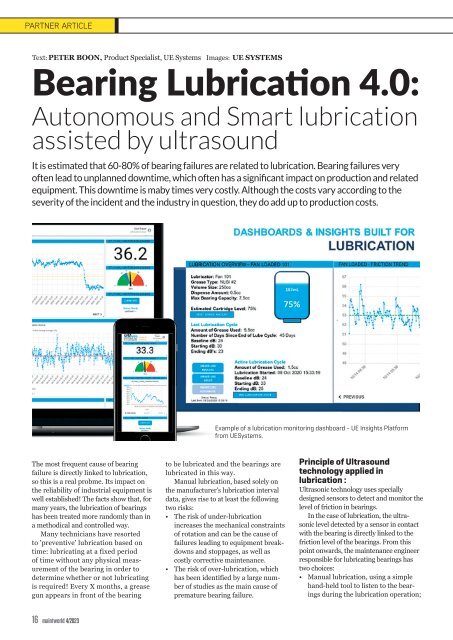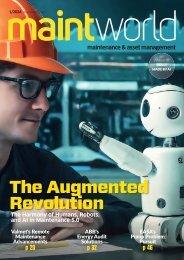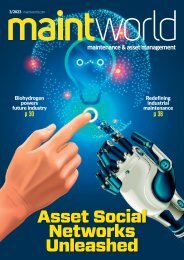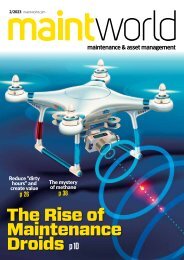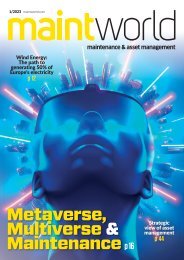Maintworld Magazine 4/2023
- maintenance & asset management
- maintenance & asset management
You also want an ePaper? Increase the reach of your titles
YUMPU automatically turns print PDFs into web optimized ePapers that Google loves.
PARTNER ARTICLE<br />
Text: PETER BOON, Product Specialist, UE Systems Images: UE SYSTEMS<br />
Bearing Lubrication 4.0:<br />
Autonomous and Smart lubrication<br />
assisted by ultrasound<br />
It is estimated that 60-80% of bearing failures are related to lubrication. Bearing failures very<br />
often lead to unplanned downtime, which often has a significant impact on production and related<br />
equipment. This downtime is maby times very costly. Although the costs vary according to the<br />
severity of the incident and the industry in question, they do add up to production costs.<br />
Example of a lubrication monitoring dashboard - UE Insights Platform<br />
from UESystems.<br />
The most frequent cause of bearing<br />
failure is directly linked to lubrication,<br />
so this is a real probme. Its impact on<br />
the reliability of industrial equipment is<br />
well established! The facts show that, for<br />
many years, the lubrication of bearings<br />
has been treated more randomly than in<br />
a methodical and controlled way.<br />
Many technicians have resorted<br />
to 'preventive' lubrication based on<br />
time: lubricating at a fixed period<br />
of time without any physical measurement<br />
of the bearing in order to<br />
determine whether or not lubricating<br />
is required! Every X months, a grease<br />
gun appears in front of the bearing<br />
to be lubricated and the bearings are<br />
lubricated in this way.<br />
Manual lubrication, based solely on<br />
the manufacturer's lubrication interval<br />
data, gives rise to at least the following<br />
two risks:<br />
• The risk of under-lubrication<br />
increases the mechanical constraints<br />
of rotation and can be the cause of<br />
failures leading to equipment breakdowns<br />
and stoppages, as well as<br />
costly corrective maintenance.<br />
• The risk of over-lubrication, which<br />
has been identified by a large number<br />
of studies as the main cause of<br />
premature bearing failure.<br />
Principle of Ultrasound<br />
technology applied in<br />
lubrication :<br />
Ultrasonic technology uses specially<br />
designed sensors to detect and monitor the<br />
level of friction in bearings.<br />
In the case of lubrication, the ultrasonic<br />
level detected by a sensor in contact<br />
with the bearing is directly linked to the<br />
friction level of the bearings. From this<br />
point onwards, the maintenance engineer<br />
responsible for lubricating bearings has<br />
two choices:<br />
• Manual lubrication, using a simple<br />
hand-held tool to listen to the bearings<br />
during the lubrication operation;<br />
16 maintworld 4/<strong>2023</strong>


